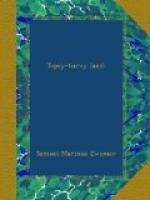Under the arch is the open fireplace where the big coffee-pots and water-kettles simmer all day on a charcoal fire. The old man looks quite cheerful seated on his uncomfortable stool made of date-sticks. You will read later about our old friend the date-palm and how the tree is used for nearly every purpose. I wish I could show you how they take the thin branches and punch holes in them and then deftly, before you can count ninety, build together a chair or a bedstead. I have often slept soundly and safely on bedsteads made of these thin leaf-sticks no bigger around than a child’s finger. The sticks are full of “spring” so one does not need a wire mattress, nor have I ever known one of them, if made honestly, to become a folding bed under a restless sleeper as they say happens sometimes in New York hotels!
Although the old man in our picture is waited on by the younger Arab (who is perhaps the keeper of the cafe), yet I know he is not rich. Do you notice his toil-worn hands and the patch on the shoulder of his long overcoat? I fancy too his pretty vest, so carefully buttoned by more than a dozen cloth buttons, is a little torn on one side; nor has he a fine girdle like the rich shopkeepers.
[Illustration: SABBACH-KUM BIL KHEIR!]
Extremes meet in the picture and three countries widely apart on the map are brought close together. Of course, you know the coffee is the real Yemen article, which coming first from Mocha on the Red Sea, is still called by that Arabian name. The curious pipe with its round bottom, carved head-piece and long stem, is used everywhere in Arabia and is generally called "nargeelie," which is the Indian name for cocoanut. The bowl of the pipe is in fact an empty cocoanut shell; the stem once grew in the jungle and perhaps tigers brushed past it; now it is pierced to draw smoke.
The curious pipe is from India, the tobacco first came from America but the coffee is Arabian. Let us listen to the story of the cup of coffee: In a book published in 1566 by an Arab scholar on the virtues of coffee it is stated that a knowledge of coffee was first brought to Arabia from Abyssinia about the year 1400 by a pious man whose tomb is still venerated in Yemen. The knowledge of coffee spread from Yemen in south Arabia over the whole world. In 1690 Van Hoorne, a general of the Dutch East India company, received a few coffee seeds from the Arabs at Mocha and planted them in Batavia on the island of Java. In this way Mocha coffee has become the mother of Java and of all other kinds of coffee sold at your grocers’. Nothing can be more beautiful than the green hills and fertile gardens in the Arabian coffee country. The coffee berry grows on an evergreen tree of about eighteen feet high; its leaves are a beautiful dark, shining green and the blossom of the tree is pure white with a most delicate and fragrant odour. Each tree bears an enormous number of coffee-berries; a single tree




